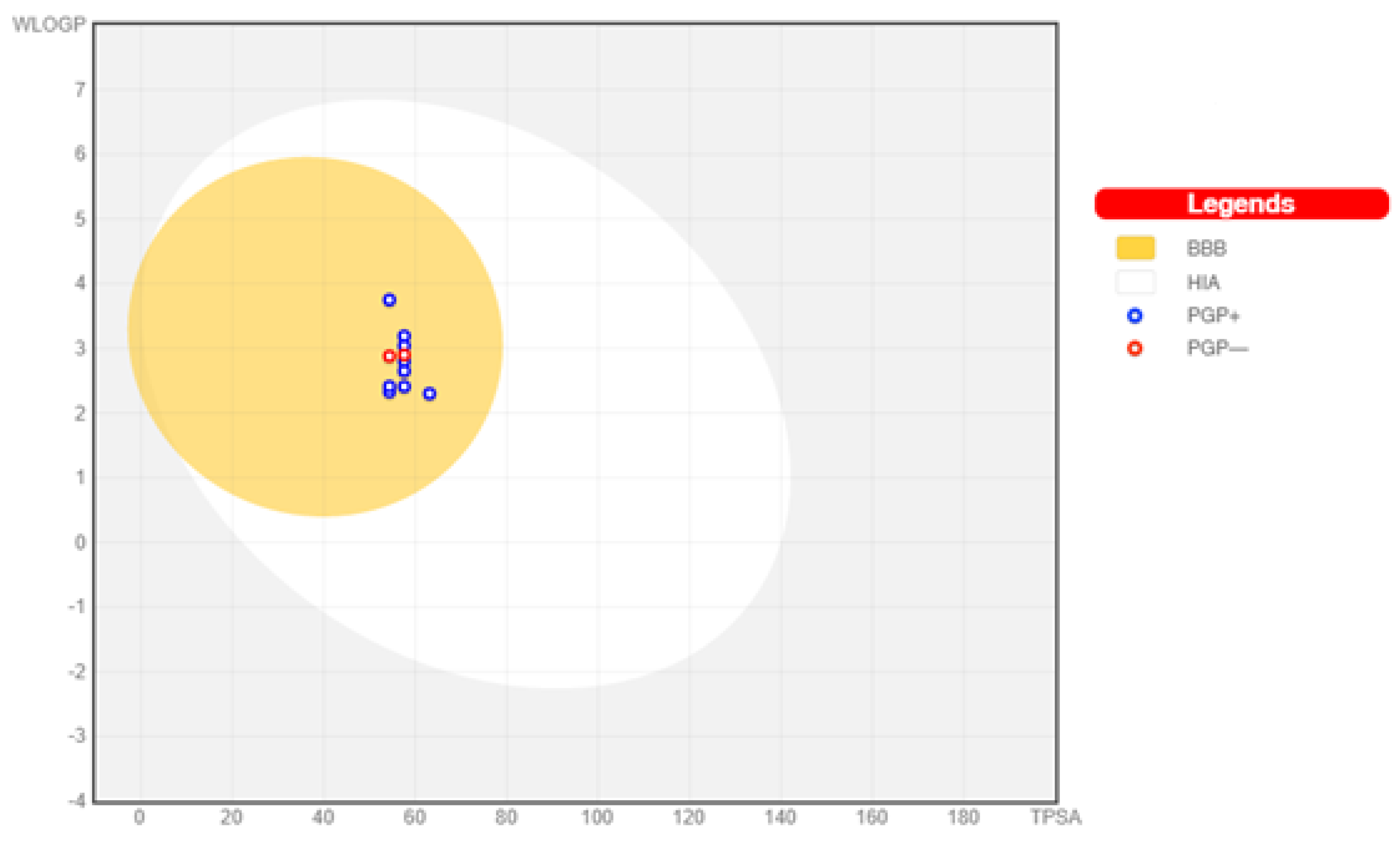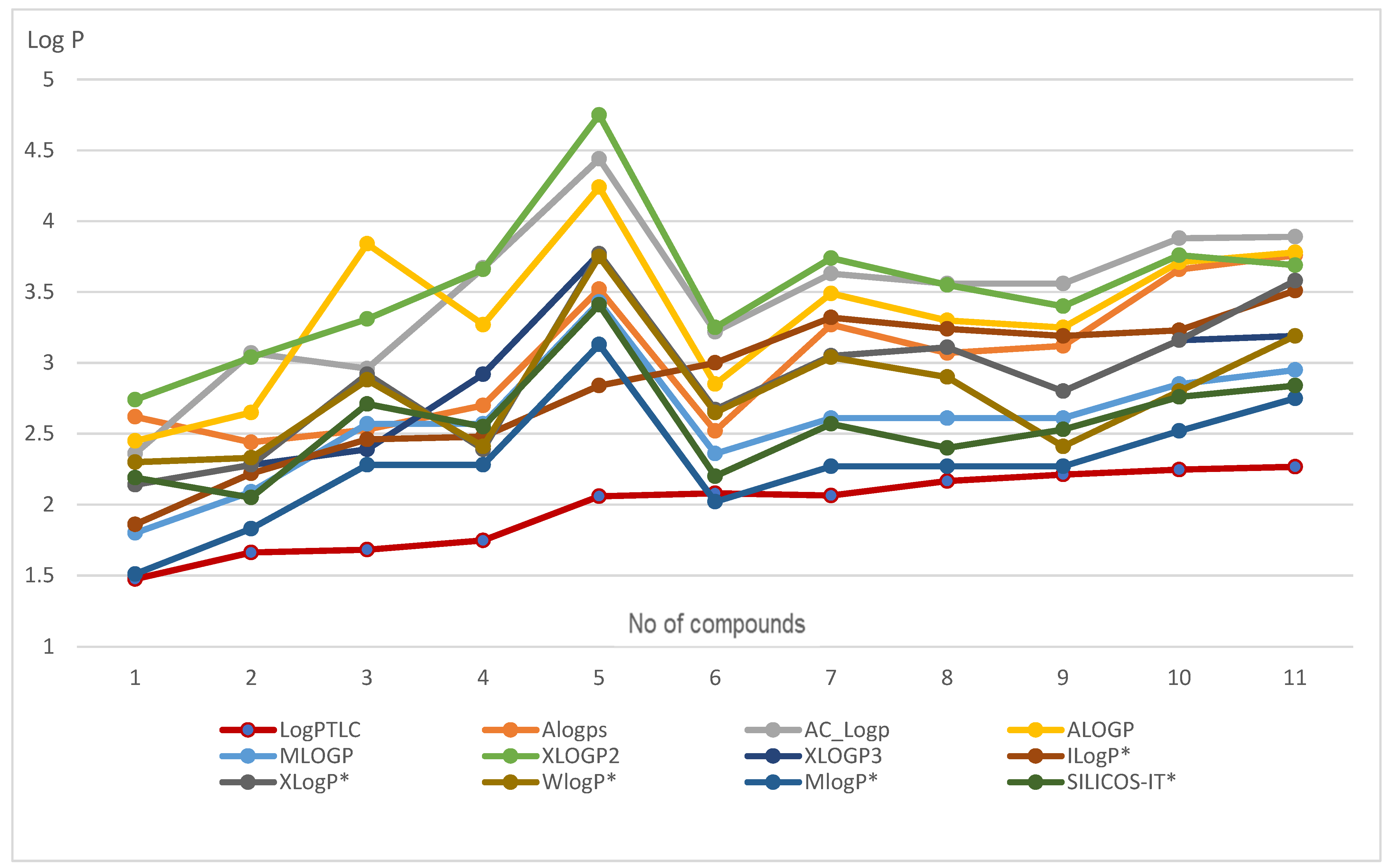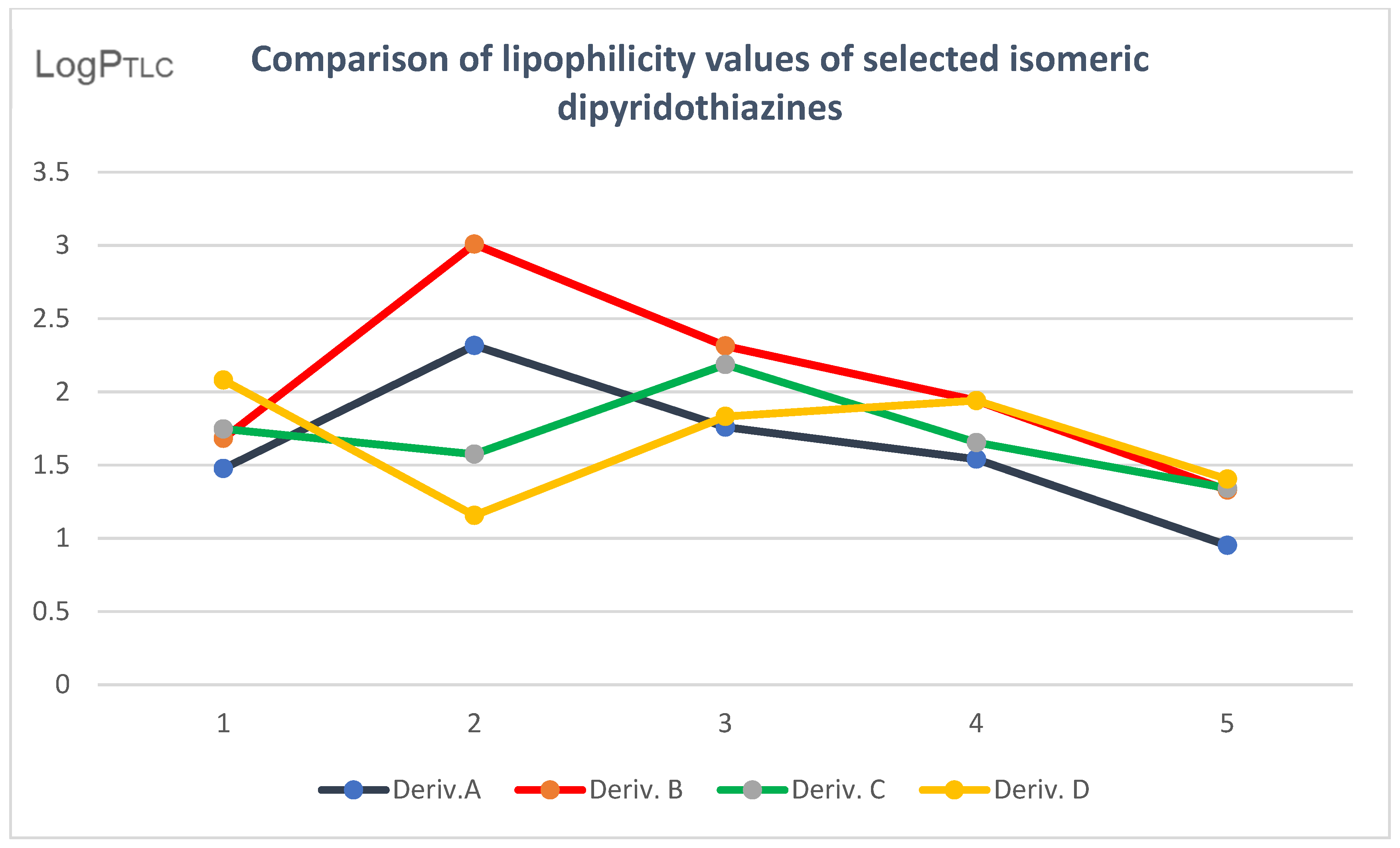Study of Lipophilicity and ADME Properties of 1,9-Diazaphenothiazines with Anticancer Action
Abstract
1. Introduction
2. Results
3. Discussion
4. Materials and Methods
4.1. Reagents
4.2. Chromatographic Procedure
4.3. Theoretical Lipophilicity and ADMET Parameters, Target Prediction
5. Conclusions
Author Contributions
Funding
Institutional Review Board Statement
Informed Consent Statement
Data Availability Statement
Conflicts of Interest
Sample Availability
References
- Constantinescu, T.; Lungu, C.N.; Lung, I. Lipophilicity as a Central Component of Drug-Like Properties of Chalchones and Flavonoid Derivatives. Molecules 2019, 24, 1505. [Google Scholar] [CrossRef] [PubMed]
- Giaginis, C.; Tsopelas, F.; Tsantili-Kakoulidou, A. The Impact of Lipophilicity in Drug Discovery: Rapid Measurements by Means of Reversed-Phase HPLC. In Rational Drug Design. Methods in Molecular Biology; Mavromoustakos, T., Kellici, T.F., Eds.; Springer: New York, NY, USA, 2018; Volume 1824, pp. 217–228. [Google Scholar]
- Kamel, M.S.; Belal, A.; Aboelez, M.O.; Shokr, E.K.; Abdel-Ghany, H.; Mansour, H.S.; Shawky, M.A.; Abd El Aleem Ali Ali El-Remaily, M. Microwave-Assisted Synthesis, Biological Activ-ity Evaluation, Molecular Docking, and ADMET Studies of Some Novel Pyrrolo [2,3-b] Pyrrole Derivatives. Molecules 2022, 27, 2061. [Google Scholar] [CrossRef]
- Erckes, V.; Steuer, C. A story of peptides, lipophilicity and chromatography—Back and forth in time. RSC Med. Chem. 2022, 22, 676–687. [Google Scholar] [CrossRef] [PubMed]
- Ginex, T.; Vazquez, J.; Gilbert, E.; Herrero, E.; Luque, F.J. Lipophilicity in drug design: An overview of lipophilicity descriptors in 3D-QSAR studies. Future Med. Chem. 2019, 11, 1177–1193. [Google Scholar] [CrossRef]
- Kempińska, D.; Chmiel, T.; Kot-Wasik, A.; Mróz, A.; Mazerska, Z.; Namieśnik, J. State of the art and prospects of methods for determination of lipophilicity of chemical compounds. Trends Anal. Chem. 2019, 113, 54–73. [Google Scholar] [CrossRef]
- Dołowy, M.; Jampilek, J.; Bober-Majnusz, K. A comparative study of the lipophilicity of metformin and phenformin. Molecules 2021, 26, 6613. [Google Scholar] [CrossRef] [PubMed]
- Manto Chagasa, C.; Mossa, S.; Alisaraie, L. Drug metabolites and their effects on the development of adverse reactions: Revisiting Lipinski’s Rule of Five. Int. J. Pharm. 2018, 549, 133–149. [Google Scholar] [CrossRef]
- Lobo, S. Is there enough focus on lipophilicity in drug discovery? Expert Opin. Drug Discov. 2020, 15, 261–263. [Google Scholar] [CrossRef]
- Piir, G.; Kahn, I.; García-Sosa, A.T.; Sild, S.; Ahte, P.; Maran, U. Best Practices for QSAR Model Reporting: Physical and Chemical Properties, Ecotoxicity, Environmental Fate, Human Health, and Toxicokinetics Endpoints. Environ. Health Perspect. 2018, 126, 126001. [Google Scholar] [CrossRef]
- Tsaioun, K. Evidence-based absorption, distribution, metabolism, excretion (ADME) and its interplay with alternative toxicity methods. ALTEX 2016, 33, 343–358. [Google Scholar] [CrossRef]
- Halder, A.K.; Moura, A.S.; Cordeiro, M.N.D.S. QSAR modelling: A therapeutic patent review 2010-present. Expert Opin. Ther. Pat. 2018, 28, 467–476. [Google Scholar] [CrossRef] [PubMed]
- Alqahtani, M.S.; Kazi, M.; Alsenaidy, M.A.; Ahmad, M.A. Advances in Oral Drug Delivery. Front. Pharm. 2021, 19, 618411. [Google Scholar] [CrossRef]
- Kathuria, H.; Handral, H.K.; Cha, S.; Nguyen, D.T.P.; Cai, J.; Cao, T.; Wu, C.; Kang, F. Enhancement of Skin Delivery of Drugs Using Proposome Depends on Drug Lipophilicity. Pharmaceutics 2021, 13, 1457. [Google Scholar] [CrossRef] [PubMed]
- Han, S.; Mei, L.; Quach, T.; Porter, C.; Trevaskis, N. Lipophilic Conjugates of Drugs: A Tool to Improve Drug Pharmacokinetic and Therapeutic Profiles. Pharm. Res. 2021, 38, 1497–1518. [Google Scholar] [CrossRef]
- Morak-Młodawska, B.; Pluta, K.; Latocha, M.; Jeleń, M.; Kuśmierz, D.; Suwińska, K.; Shkurenko, A.; Czuba, Z.; Jurzak, M. 10H-1,9-diazaphenothiazine and its 10-derivatives: Synthesis, characterisation and biological evaluation as potential anticancer agents. J. Enzyme Inhib. Med. Chem. 2019, 34, 1298–1306. [Google Scholar] [CrossRef]
- Ahmed, S.A.; Kamel, M.S.; Aboelez, M.O.; Ma, X.; Al-Karmalawy, A.A.; Mousa, S.A.S.; Shokr, E.K.; Abdel-Ghany, H.; Belal, A.; El Hamd, M.A.; et al. Thieno[2,3-b]thiophene Derivatives as Potential EGFRWT and EGFRT790M Inhibitors with Antioxidant Activities: Microwave-Assisted Synthesis and Quantitative In Vitro and In Silico Studies. ACS Omega 2022, 7, 45535–45544. [Google Scholar] [CrossRef]
- Elkanzi, N.A.A.; Kadry, A.M.; Ryad, R.M.; Bakr, R.B.; Abd El Aleem Ali Ali El-Remaily, M.; Ali, M.A. Efficient and Recoverable Bio-Organic Catalyst Cysteine for Synthesis, Docking Study, and Antifungal Activity of New Bio-Active 3,4-Dihydropyrimidin-2(1H)-ones/thiones Under Microwave Irradiation. ACS Omega 2022, 26, 22839–22849. [Google Scholar] [CrossRef] [PubMed]
- Morak-Młodawska, B.; Pluta, K.; Jeleń, M. Phenothiazines Modified with the Pyridine Ring as Promising Anticancer Agents. Life 2021, 11, 206. [Google Scholar] [CrossRef]
- Available online: http://www.vcclab.org (accessed on 20 November 2022).
- Available online: http://swissadme.ch (accessed on 11 November 2022).
- Bodor, N.; Gabanyi, Z.; Wong, C.K. A new method for the estimation of partition coefficient. J. Am. Chem. Soc. 1989, 111, 3783–3786. [Google Scholar] [CrossRef]
- Mannhold, R.; Cruciani, G.; Dross, K.; Rekker, R. Multivariate analysis of experimental and computational descriptors of molecular lipophilicity. J. Comput. Mol. Des. 1998, 12, 573–581. [Google Scholar] [CrossRef]
- Available online: http://preadmet.bmdrc.org (accessed on 22 September 2022).
- Daina, A.; Zoete, V. A BOILED-Egg To Predict Gastrointestinal Absorption and Brain Penetration of Small Molecules. ChemMedChem 2016, 6, 1117–1121. [Google Scholar] [CrossRef] [PubMed]
- Available online: http://www.swisstargetprediction.ch/ (accessed on 14 November 2022).
- Morak-Młodawska, B.; Jeleń, M. Lipophilicity and Pharmacokinetic Properties of New Anticancer Dipyridothiazine with 1,2,3-Triazole Substituents. Molecules 2022, 27, 1253. [Google Scholar] [CrossRef] [PubMed]
- Morak-Młodawska, B.; Pluta, K.; Jeleń, M. Evaluation of the Lipophilicity of New Anticancer 1,2,3-Triazole-Dipyridothiazine Hybrids Using RP TLC and Different Computational Methods. Processes 2020, 8, 858. [Google Scholar] [CrossRef]
- Kadela-Tomanek, M.; Jastrzębska, M.; Chrobak, E.; Bębenek, E. Lipophilicity and ADMET Analysis of Quinoline-1,4-quinoneHybrids. Pharmaceutics 2023, 15, 34. [Google Scholar] [CrossRef]
- Morak-Młodawska, B.; Pluta, K.; Jeleń, M. Lipophilicity of New Anticancer 1,6- and 3,6-diazaphenothiazines by of Use RP TLC and Different Computational Methods. J. Chrom. Sci. 2018, 56, 376–381. [Google Scholar] [CrossRef]
- Morak-Młodawska, B.; Pluta, K.; Jeleń, M. Estimation of the Lipophilicity of New Anticancer and Immunosuppressive 1,8-Diazaphenothiazine Derivatives. J. Chrom. Sci. 2015, 53, 462–466. [Google Scholar] [CrossRef]
- Morak-Młodawska, B.; Pluta, K.; Latocha, M.; Jeleń, M.; Kuśmierz, D. Synthesis and anticancer and lipophilic properties of 10- dialkylaminobutynyl derivatives of 1,8- and 2,7-diazaphenothiazines. J. Enzym. Inhib. Med. Chem. 2016, 31, 1132–1138. [Google Scholar] [CrossRef]
- Morak, B.; Nowak, M.; Pluta, K. Determination of the Lipophilicity Parameters RM0 and Log P of New Azaphenothiazines by Reversed-Phase Thin-Layer Chromatography. J. Liq. Chromatogr. Relat. Technol. 2007, 30, 1845–1854. [Google Scholar] [CrossRef]





| No | Alogps | AC_Logp | ALOGP | MLOGP | XLOGP2 | XLOGP3 | ILogP * | XLogP * | WlogP * | MlogP * | SILICOS-IT * |
|---|---|---|---|---|---|---|---|---|---|---|---|
| 1 | 2.62 | 2.36 | 2.45 | 1.80 | 2.74 | 2.14 | 1.86 | 2.14 | 2.30 | 1.51 | 2.19 |
| 2 | 2.44 | 3.07 | 2.65 | 2.09 | 3.04 | 2.28 | 2.22 | 2.28 | 2.33 | 1.83 | 2.05 |
| 3 | 2.53 | 2.96 | 3.84 | 2.57 | 3.31 | 2.39 | 2.46 | 2.92 | 2.88 | 2.28 | 2.71 |
| 4 | 2.70 | 3.67 | 3.27 | 2.57 | 3.66 | 2.92 | 2.48 | 2.39 | 2.41 | 2.28 | 2.55 |
| 5 | 3.52 | 4.44 | 4.24 | 3.43 | 4.75 | 3.77 | 2.84 | 3.77 | 3.75 | 3.13 | 3.41 |
| 6 | 2.52 | 3.22 | 2.85 | 2.36 | 3.25 | 2.67 | 3.00 | 2.67 | 2.65 | 2.02 | 2.20 |
| 7 | 3.27 | 3.63 | 3.49 | 2.61 | 3.74 | 3.05 | 3.32 | 3.05 | 3.04 | 2.27 | 2.57 |
| 8 | 3.07 | 3.56 | 3.30 | 2.61 | 3.55 | 3.11 | 3.24 | 3.11 | 2.90 | 2.27 | 2.40 |
| 9 | 3.12 | 3.56 | 3.25 | 2.61 | 3.40 | 2.80 | 3.19 | 2.80 | 2.41 | 2.27 | 2.53 |
| 10 | 3.66 | 3.88 | 3.71 | 2.85 | 3.76 | 3.16 | 3.23 | 3.16 | 2.80 | 2.52 | 2.76 |
| 11 | 3.76 | 3.89 | 3.78 | 2.95 | 3.69 | 3.19 | 3.51 | 3.58 | 3.19 | 2.75 | 2.84 |
| No | −b | RM0 | r |
|---|---|---|---|
| 1 | 0.0205 | 1.1970 | 0.9916 |
| 2 | 0.0192 | 1.3850 | 0.9954 |
| 3 | 0.0278 | 1.4052 | 0.9949 |
| 4 | 0.0195 | 1.4720 | 0.9985 |
| 5 | 0.0205 | 1.7877 | 0.9868 |
| 6 | 0.0170 | 1.8096 | 0.9973 |
| 7 | 0.0180 | 1.7934 | 0.9168 |
| 8 | 0.0228 | 1.8961 | 0.9319 |
| 9 | 0.0123 | 1.9434 | 0.9891 |
| 10 | 0.0214 | 1.9781 | 0.9485 |
| 11 | 0.0211 | 1.9988 | 0.9686 |
| Parameters | I | II | III | IV | V |
|---|---|---|---|---|---|
| logPTLC | 1.21 [22] | 1.58 [22] | 2.43 [23] | 3.18 [22] | 5.53 [22] |
| RM0 | 1.011 | 1.601 | 2.281 | 2.996 | 3.588 |
| −b | 0.018 | 0.019 | 0.033 | 0.034 | 0.044 |
| r | 0.9964 | 0.9967 | 0.9961 | 0.9842 | 0.9864 |
| No of Investigated Compounds | |||||||||||
|---|---|---|---|---|---|---|---|---|---|---|---|
| 1 | 2 | 3 | 4 | 5 | 6 | 7 | 8 | 9 | 10 | 11 | |
| logPTLC | 1.476 | 1.662 | 1.682 | 1.747 | 2.059 | 2.080 | 2.064 | 2.166 | 2.212 | 2.247 | 2.267 |
| No | Molecular Mass (M) | H-Bond Acceptors | H-Bond Donors | Rotatable Bonds | Molar Refractivity | TPSA | P-gp Substrate | Lipinski’s Rules | Ghose’s Rules | Veber’s Rules |
|---|---|---|---|---|---|---|---|---|---|---|
| 1 | 201 | 2 | 1 | 0 | 58.63 | 63.11 | + | + | + | + |
| 2 | 215 | 2 | 0 | 0 | 63.54 | 54.32 | + | + | + | + |
| 3 | 241 | 2 | 0 | 2 | 72.68 | 54.32 | - | + | + | + |
| 4 | 239 | 2 | 0 | 1 | 71.31 | 54.32 | + | + | + | + |
| 5 | 291 | 2 | 0 | 2 | 88.02 | 54.32 | + | + | + | + |
| 6 | 286 | 3 | 0 | 4 | 85.66 | 57.56 | + | + | + | + |
| 7 | 300 | 3 | 0 | 5 | 90.47 | 57.56 | + | + | + | + |
| 8 | 300 | 3 | 0 | 4 | 90.47 | 57.56 | - | + | + | + |
| 9 | 298 | 3 | 0 | 3 | 92.27 | 57.56 | + | + | + | + |
| 10 | 312 | 3 | 0 | 3 | 97.07 | 57.07 | + | + | + | + |
| 11 | 326 | 3 | 0 | 3 | 101.88 | 57.56 | + | + | + | + |
| No | 1 | 2 | 3 | 4 | 5 | 6 | 7 | 8 | 9 | 10 | 11 | 12 |
|---|---|---|---|---|---|---|---|---|---|---|---|---|
| BBB | 1.02 | 2.36 | 3.06 | 3.36 | 4.45 | 2.40 | 3.17 | 2.97 | 2.91 | 1.26 | 0.85 | 2.40 |
| Caco-2 | 25.41 | 27.81 | 25.07 | 24.30 | 25.39 | 22.55 | 22.61 | 22.81 | 24.14 | 24.00 | 23.92 | 22.55 |
| HIA | 95.81 | 98.05 | 97.67 | 97.71 | 97.37 | 97.78 | 97.66 | 97.66 | 97.66 | 97.57 | 97.49 | 97.78 |
| MDCK | 59.28 | 52.80 | 26.47 | 9.12 | 3.73 | 37.63 | 80.31 | 26.77 | 60.18 | 52.03 | 9.17 | 37.63 |
| PPB | 99.77 | 93.89 | 88.37 | 88.12 | 96.53 | 68.57 | 78.56 | 74.82 | 74.86 | 82.47 | 80.83 | 68.57 |
| SP | −3.36 | −3.24 | −3.14 | −2.92 | −2.94 | −3.50 | −3.32 | −3.36 | −3.76 | −3.62 | −3.58 | −3.50 |
| No of Compound | ADME Activities | Equation | r |
|---|---|---|---|
| 1–11 | BBB | BBB = 14.86 RM03 + 54.304 RM02 − 57.146 RM0 + 17.105 | 0.8616 |
| 1–11 | Caco-2 | Caco-2 = 37.616 RM03 − 178.2 RM02 + 273.43 RM0 − 110.91 | 0.7191 |
| 1–11 | HIA | HIA = 7.29 RM02 + 24.557 RM0 + 77.334 | 0.7962 |
| 1–11 | MDCK | MDCK = 529.07 RM03 + 2648.5 RM02 + 93449 RM0 – 35,341 | 0.6205 |
| 1–11 | PPB | PPB = 30.856 RM02 − 125.38 RM0 + 205.96 | 0.7335 |
| 1–11 | SP | SP = −3.0033 RM02 + 9.2228 RM0 − 10.128 | 0.8115 |
| No | Probable Targets |
|---|---|
| 1 | Family C G protein, unclasificated protein, enzyme |
| 2 | Proteaze, Family C G protein, cytochrome 450 |
| 3 | Cytochrome 450, kinase, electrochemical transporter |
| 4 | Unclasificated protein, enzyme, kinase |
| 5 | Phosphodiesterase, enzyme, kinase |
| 6 | Kinase, protease, family AG protein |
| 7 | Enzyme, protease, family AG protein |
| 8 | Family AG protein, kinase, ligand-gate ion channel |
| 9 | Family AG protein, ligand-gate ion channel, kinase |
| 10 | Family AG protein, ligand-gate ion channel, kinase |
| 11 | Family AG protein, ligand-gate ion channel, kinase |
| Substituent R | 1,9-Diaza | 1,6-Diaza [30]  | 1,8-Diaza [31] | 2,7-Diaza [32,33] | 3,6-Diaza [30] |
|---|---|---|---|---|---|
| A. H | 1.476 | 2.316 | 1.759 | 1.540 | 0.952 |
| B. CH2CH=CH2 | 1.682 | 3.008 | 2.313 | 1.940 | 1.329 |
| C. CH2CCH | 1.747 | 1.574 | 2.186 | 1.654 | 1.342 |
| D. CH2CH2CH2N(CH3)2 | 2.080 | 1.156 | 1.832 | 1.940 | 1.404 |
Disclaimer/Publisher’s Note: The statements, opinions and data contained in all publications are solely those of the individual author(s) and contributor(s) and not of MDPI and/or the editor(s). MDPI and/or the editor(s) disclaim responsibility for any injury to people or property resulting from any ideas, methods, instructions or products referred to in the content. |
© 2023 by the authors. Licensee MDPI, Basel, Switzerland. This article is an open access article distributed under the terms and conditions of the Creative Commons Attribution (CC BY) license (https://creativecommons.org/licenses/by/4.0/).
Share and Cite
Morak-Młodawska, B.; Jeleń, M.; Martula, E.; Korlacki, R. Study of Lipophilicity and ADME Properties of 1,9-Diazaphenothiazines with Anticancer Action. Int. J. Mol. Sci. 2023, 24, 6970. https://doi.org/10.3390/ijms24086970
Morak-Młodawska B, Jeleń M, Martula E, Korlacki R. Study of Lipophilicity and ADME Properties of 1,9-Diazaphenothiazines with Anticancer Action. International Journal of Molecular Sciences. 2023; 24(8):6970. https://doi.org/10.3390/ijms24086970
Chicago/Turabian StyleMorak-Młodawska, Beata, Małgorzata Jeleń, Emilia Martula, and Rafał Korlacki. 2023. "Study of Lipophilicity and ADME Properties of 1,9-Diazaphenothiazines with Anticancer Action" International Journal of Molecular Sciences 24, no. 8: 6970. https://doi.org/10.3390/ijms24086970
APA StyleMorak-Młodawska, B., Jeleń, M., Martula, E., & Korlacki, R. (2023). Study of Lipophilicity and ADME Properties of 1,9-Diazaphenothiazines with Anticancer Action. International Journal of Molecular Sciences, 24(8), 6970. https://doi.org/10.3390/ijms24086970







